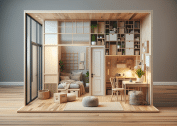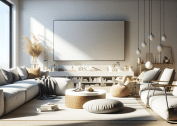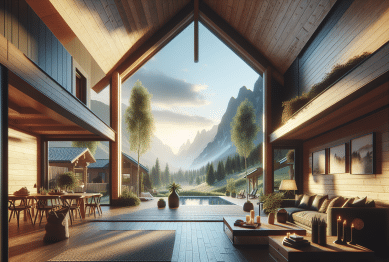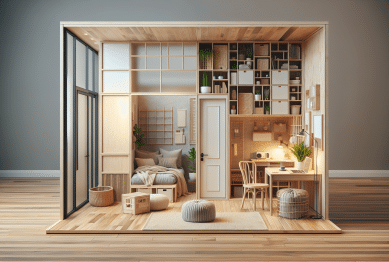Curious about why minimalist interior design remains a go-to choice for so many? Uncover how clean lines, smart storage, and mindful color choices create peaceful, inviting spaces that feel just right for modern lifestyles. Welcome to a guide that makes decluttered living approachable and rewarding.
The Core Principles of Minimalist Interior Design
Minimalist interior design revolves around the idea that less can truly be more. It swaps excess for essential, focusing attention on the use of space, light, and purposeful decor. By paring down a room to its essentials, minimalist design allows each element to stand out, from a carefully chosen armchair to the subtle texture of a wool rug. The style follows a philosophy rooted in intentionality and freedom from visual clutter. These choices not only create calm but also highlight the function of every object in a room—a vital consideration in rooms that need to work for everyday living, not just for show. Clean lines, uncluttered spaces, and quality over quantity are at its heart, producing an atmosphere that feels spacious even in compact homes.
Simplicity is not just about empty space in minimalist interior design—it’s about smart arrangement and the thoughtful curation of personal items. In a world full of distractions, a minimalist approach encourages clarity of mind, reducing stress that often accompanies excess. The use of geometric shapes and intuitive layouts supports ease of movement, making homes not only visually clean but also supremely functional. Often, the style employs neutral color palettes, which foster unity and encourage a sense of relaxation—a key reason why so many urban dwellers now gravitate towards this aesthetic for their apartments and lofts.
Minimalism as a lifestyle extends beyond just home decor; it can bring balance and intention to everyday routines. When embracing minimalist interior design, individuals tend to become more selective with purchases, prioritizing longevity over fleeting trends. This mindful consumption results in spaces that age gracefully, adapting to seasonal tweaks and personal growth. Over time, the practice helps to create interiors that are resilient and relevant, yet always welcoming and reflective of the people living in them. The success of minimalist spaces lies in their ability to evolve while always maintaining core values of simplicity and clarity.
Choosing Colors, Materials, and Light in Minimalism
Color selection is foundational in minimalist interior design, acting as the backdrop for serene, harmonious spaces. Most minimalist spaces rely on neutral palettes: shades of white, beige, gray, and the occasional black accent create an atmosphere of calm and unity. These hues are timeless, allowing furnishings and personal items to really shine without visual competition. When accent colors do appear, they’re typically subdued—think soft blues or muted greens—to maintain a tranquil aesthetic. The clarity of color choice sets the tone for the rest of a room, establishing a visual consistency that’s easy on the eyes and mind. Ambient lighting, both natural and artificial, plays a critical role in this context, enhancing the openness and airiness characteristic of minimalism.
Materials in minimalist spaces are chosen for both beauty and function. You’ll often see hardwood floors, stone countertops, and simple ceramics, which all add a tactile quality without overwhelming the senses. The interplay between soft textiles—like linen, cotton, or wool—and smooth surfaces such as glass or bare walls helps maintain a balanced interior. Sunlight is maximized wherever possible. Large windows with minimal dressings, mirrors, and reflective surfaces help to bounce light throughout the space, reducing the need for heavy artificial lighting while emphasizing architectural features. This approach creates rooms that feel open and welcoming, even in smaller dwellings.
Minimalist interiors don’t just look clean—they feel calm because every material and color has a clear purpose. Many homeowners notice that, over time, their preferences migrate toward organic, sustainable materials. This trend reflects broader social interest in eco-friendly living and personal well-being. The conscious choice of materials isn’t purely aesthetic; it also relates to healthier indoor air quality and a reduced ecological footprint. A minimalist’s love for authenticity in textures and finishes results in spaces with character—never sterile or cold, but instead streamlined and full of quiet energy that sustains through daily routines.
Smart Storage: Concealed Solutions for an Orderly Life
Keeping clutter out of sight and mind is one of the trademarks of minimalist interior design. Clever storage makes this possible too. Built-in cabinetry, under-bed drawers, and wall-mounted shelving allow for the orderly storage of essentials without sacrificing precious square footage or aesthetic value. When storage is integrated—rather than added as an afterthought—rooms feel more open, and daily tidying becomes effortless. The integration of storage means less visible chaos, less distraction, and more space to focus on what truly matters: living and relaxing.
Furniture in minimalist homes often serves multiple purposes. Think ottomans that double as storage boxes or benches with hidden compartments. This dual functionality is especially important in smaller urban homes, where every inch counts. The philosophy of ‘a place for everything and everything in its place’ rings especially true here, helping families and individuals maintain clear surfaces and a sense of peace. Minimalist storage solutions are about both hiding away and highlighting—display shelves let favorite items take center stage while the rest remains tucked away.
Externalizing clutter can become a habit with the right setup. Minimalist interiors frequently employ baskets, trays, and concealed cabinets to streamline routines. This extends to digital devices too, with technology integrated snugly into cabinets or behind panels. The result? Spaces where comfort and convenience meet—homes that stay tidy almost effortlessly, allowing more time for leisure and creativity. This shift in home organization brings ongoing satisfaction, transforming both how a room looks and how life feels day-to-day.
The Psychological Effects of Minimalist Spaces
Minimalist spaces are celebrated for their calming impact. The absence of excess allows for clearer thinking, improved focus, and lower stress levels—attributes particularly valued in today’s overstimulated world. People often report feeling more at ease and energized when they spend time in uncluttered homes. These psychological effects have roots in environmental psychology, showing that a tidy, structured environment fosters mental clarity and emotional balance. Minimalism can serve as a form of self-care by providing a peaceful retreat from external chaos and demands.
There are practical benefits as well. Research shows that people living in more organized environments are better able to sustain healthy routines, from consistent sleep schedules to nutritious meal planning. The flow of minimalist spaces, often featuring logical zones for work and relaxation, supports productivity, creativity, and even social interaction. With distractions minimized, relationships and hobbies can grow in a home that feels nurturing rather than overwhelming. This resonance between space and well-being continues to attract enthusiasts to minimalist design year after year.
Embracing a minimalist aesthetic can even support self-discovery and personal growth. By learning to value quality over quantity—choosing what truly matters—people often find greater satisfaction and contentment. Many find joy not in acquiring more, but in appreciating what they already have, leading to a shift in consumption habits. The rise of digital minimalism, where people also reduce online clutter, is a testament to the holistic appeal of this lifestyle. Ultimately, minimalist interiors pave the way for richer day-to-day experiences, inside and out.
How to Start Your Own Minimalist Transformation
Beginning a minimalist interior design journey starts with reflection and intention. Ask what function each room needs to serve and which items support those functions best. Removing what is no longer needed makes space for what is truly valued, both visually and emotionally. Start with one room or even one corner—a cluttered desk, an overcrowded bookshelf. As positive effects become visible, motivation grows to continue simplifying the rest of the home. The key is to take it step by step; minimalism does not require perfection but rewards persistence and patience.
Set a budget and choose investments wisely. Quality furniture with timeless appeal, neutral paint colors, and versatile storage should be prioritized. Remember, a minimalist home is not bare or empty—it’s filled with purpose. Use inspiration from design books, online galleries, or minimalist blogs to help curate a personal vision. Collaboration with family or housemates can make the process more effective and enjoyable, ensuring spaces reflect everyone’s needs and routines. Over time, confidence grows as spaces become calming backdrops to life’s activities.
Adapting to minimalist design does not mean giving up comfort or style. On the contrary, it allows for creative expression within a thoughtful framework. Experiment with arranging furniture to maximize light flow or hang a treasured piece of art for visual interest. Invest in a few high-impact decor pieces—but avoid overcrowding. Establish routines for maintenance, like daily tidying or monthly decluttering. Sustainable practices—recycling, upcycling, and mindful buying—support both the environment and a lasting minimalist lifestyle. By taking these steps, anyone can enjoy the peace and beauty that a minimalist interior brings.
Minimalism and the Rise of Sustainable Design
The minimalist movement has dovetailed with growing interest in sustainability. Minimalist interiors naturally consume fewer resources by emphasizing durability and functionality over trend-driven excess. Choosing materials like bamboo, reclaimed wood, and recycled steel addresses environmental concerns while adding unique character to homes. This approach helps reduce waste, lower energy bills, and support greener manufacturing practices. The synergy between minimalism and eco-friendliness means homeowners no longer have to choose between style and sustainability—they can blend both seamlessly.
Sustainable minimalist design embraces slow decorating—making incremental changes with intention rather than following fast-paced trends. Vintage furniture and secondhand finds get new life within minimalist settings, reducing demand for newly manufactured goods. Plant-based paints or low-VOC finishes also contribute to healthier indoor air. Small touches, such as introducing houseplants or energy-efficient lighting, reinforce a connection to nature and foster an environment where people and the planet thrive together. This holistic perspective has inspired new generations of eco-conscious designers and homeowners alike.
The minimalist mindset extends into daily lifestyle choices, from using reusable products to choosing ethically produced decor. This ethos supports broader cultural shifts toward sustainability, well-being, and mindfulness. Over time, these efforts ripple outward, influencing communities and shaping trends that prioritize long-term well-being over immediate gratification. Whether downsizing living spaces or reevaluating what’s truly necessary, the intersection of minimalist interior design and sustainability offers a path toward positive, lasting change—making thoughtfully designed spaces an anchor for conscious living.
References
1. American Institute of Architects. (2022). Minimalism in Modern Interior Design. Retrieved from https://www.aia.org/articles/6453782-minimalism-in-modern-interior-design
2. Harvard University Center for the Environment. (2023). Healthy Materials and Sustainable Interiors. Retrieved from https://chgeharvard.org/resource/healthy-materials-and-sustainable-interiors/
3. National Association of Home Builders. (2022). Space, Storage, and Smart Design. Retrieved from https://www.nahb.org/blog/2022/09/smart-home-design-storage
4. Environmental Protection Agency. (2023). Healthy Homes and Indoor Air Quality. Retrieved from https://www.epa.gov/indoor-air-quality-iaq/healthy-homes-and-iaq
5. Psychology Today. (2021). The Mental Health Benefits of Minimalism. Retrieved from https://www.psychologytoday.com/us/blog/modern-mentality/202105/the-mental-health-benefits-minimalism
6. National Trust for Historic Preservation. (2022). Sustainable Materials and Green Interior Choices. Retrieved from https://savingplaces.org/stories/sustainable-materials-for-your-home









